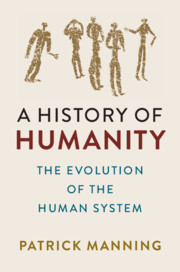Book contents
- A History of Humanity
- A History of Humanity
- Copyright page
- Contents
- Maps, Figures, and Tables
- Preface
- Acknowledgments
- Introduction
- Pleistocene Evolution
- Holocene Evolution
- 6 Society: Network versus Hierarchy
- 7 Collisions and Contraction
- 8 From Global Networks to Capitalism
- Anthropocene Evolution
- Appendix: Frameworks for Analysis
- Notes
- Glossary
- References
- Index
7 - Collisions and Contraction
from Holocene Evolution
Published online by Cambridge University Press: 14 February 2020
- A History of Humanity
- A History of Humanity
- Copyright page
- Contents
- Maps, Figures, and Tables
- Preface
- Acknowledgments
- Introduction
- Pleistocene Evolution
- Holocene Evolution
- 6 Society: Network versus Hierarchy
- 7 Collisions and Contraction
- 8 From Global Networks to Capitalism
- Anthropocene Evolution
- Appendix: Frameworks for Analysis
- Notes
- Glossary
- References
- Index
Summary
Social institutions collided from 1000 to 1600 CE, halting population growth. Gaia brought the Medieval Warm Era, nourishing prosperity from 800 to 1200 CE, until the Black Plague infected the Old World. The sixteenth-century mortality wave of the Americas reinforced population shrinkage; declining agriculture reinforced the cooling of the Little Ice Age. Meanwhile, earlier prosperity had encouraged ambitions among warriors: their bellicose emotions revealed links of social and biological human nature as they destroyed empires in China and the Mediterranean. The Mongols regime supported commerce and knowledge exchange, yet their legacy brought further warfare. Maritime encounters brought other collisions, especially after the tenth century. Transoceanic routes, completing the global trade network, spread disease, conflict, and mortality. Inherited representations of the world met with challenge: the major religions each experienced doctrinal schisms. The sixteenth century, while it offered innovative elements of global expansion, also reproduced the collisions of previous centuries, revealing the inherent challenges and limits to the human order.
- Type
- Chapter
- Information
- A History of HumanityThe Evolution of the Human System, pp. 145 - 170Publisher: Cambridge University PressPrint publication year: 2020

